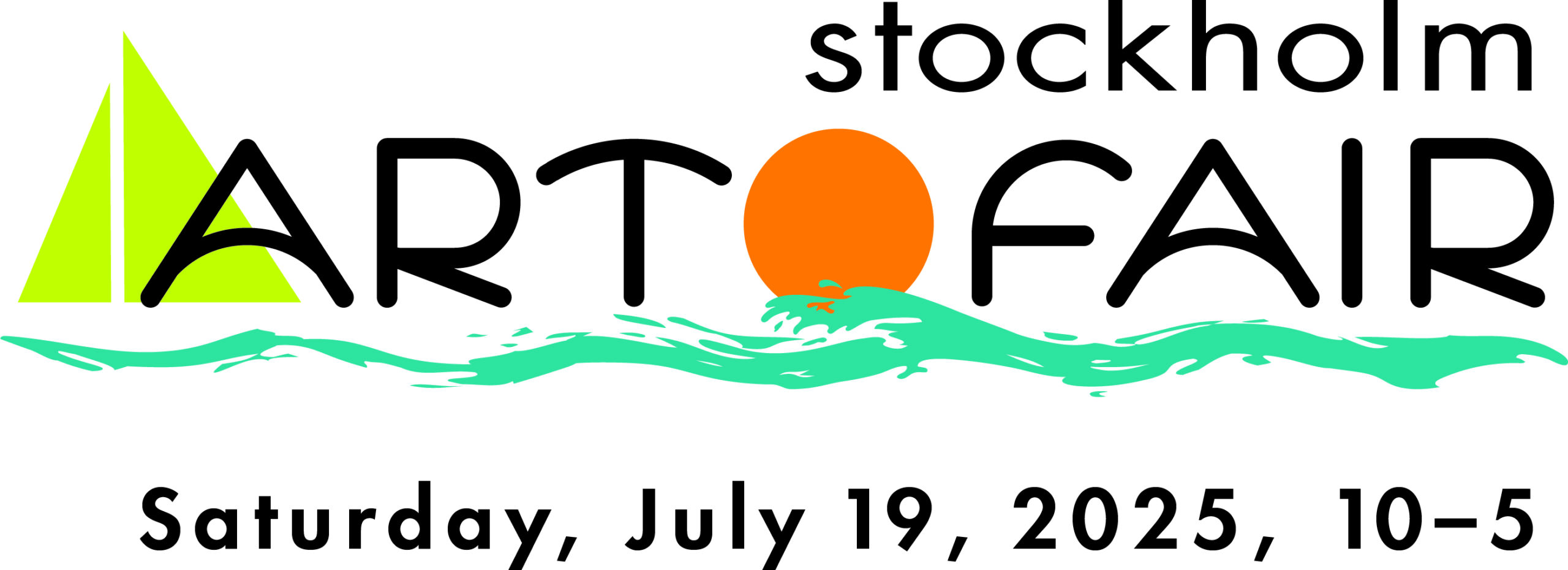It wasn’t a mass immigration. Some had been friends at the Minneapolis College of Art and Design (MCAD), but most didn’t know there were any other artists or craftspeople in the area when they moved here. The ten or so artists formed the Stockholm Artists Guild whose initial, sole activity was to organize an art fair in the Stockholm Park so that “people could see what we do”. The thinking was that if no one came, it would still be fun to get together. But people did come and actually bought artworks. And that’s when the 1st Stockholm Art Fair was launched.
For the first few years, securing a booth for the fair cost $5 and it was a “land rush” as to where an artist would set up. The Committee was split between those who wanted a date in June and those who preferred August. A compromise date of July 11th was settled on and “the third Saturday in July” became the permanent date for the art fair. A poster was created and a sign scrawled on a bed sheet was stretched with ropes across the highway to announce the upcoming event.
Friends from MCAD, the first to move to the area were the Browns and the Nelsons — Nelson Brown and the late Marilyn Brown, and Nadine and the late Glen (Sonny) Nelson. They shared a large rented house in Stockholm the first year in which they carved out some studio space. Nelson Brown, one of the few who has participated since 1973, drew caricatures and the human form and is still drawing wonderful caricatures at the fair. Sonny was known for his very large canvases in the “lyrical abstraction” style and Nadine for her “Mississippi Pearl” jewelry designs. Nadine still operates a gallery in Alma, Wisconsin by the same name.




Soon after, Art Gannett and Pam Olson moved to the area and bought 39 acres just 15 miles from Stockholm where they could set up a home and pottery studio (the same building served as both in the early years). Art has continually shown his pottery at the fair, and Pam Olson launched a gallery called “Out of the Blue” in Stockholm (she has since passed the baton to her daughter with a shop called Iris & Oak). Eric Broderson, then a woodworker, and Barbara Anderson also migrated from the Twin Cities about this time. Eric was making complex wooden toys and aiming to make furniture. Barbara was painting and drawing, and considering illustrating children’s books. In the interim, Eric moved on to become an airline pilot and Barbara found that colorfully-painted pottery was her calling.


Sören Svedvik and Remy Ceci moved to rural Stockholm as well, to get out of the cities and do what they wanted to do. Sören was making large redwood tables with an eye toward silkscreening, and Remy was learning to be a potter. They considered art careers in Sören’s native Sweden, but landed in Stockholm, Wisconsin instead. Both are still living in the area — Sören with his fine photography and Remy with her culinary talents and very green thumb. Russ Mattson opened up his shop in the former Fryklund Photography Studio in downtown Stockholm in the 70s. Initially, he made candles and candleholders made from large cans and containers cut with a welding torch. Over the years he also exhibited bonsai and didgeridoos of his making.



The Stockholm Art Fair continued with this original crew and others in the community until 1988, when the Guild decided to close the curtain on the annual event in Stockholm Village Park. The poster for the 1988 event depicts a single slice of birthday cake (a painting by Nelson Brown) announcing the final Stockholm Art Fair (ha!). But by this time, many more artists had moved into the area and a new committee was formed. Linda Day, a potter, headed up the fair for many years. And the Stockholm Art Fair continues on — now in its 50th year — only to get better and better! Changes and improvements have been made along the way by all who have generously served as directors and committee members, of course. Artists are now juried and pre-assigned booths. A music stage has been built and a shuttle bus is available to take fairgoers from a field lot into town, closer to the fairgrounds. Food offerings have gotten broader and include healthy options. There is a playground and children’s activities to make it fun for families to attend together. The planning and execution of all that goes into the event takes hundreds of hours by the director, committee members and volunteers who contribute their time and talents to help make the art fair memorable for artists and fairgoers alike. But for all the changes and growth over the past 50 years, the art fair still has the warm and welcoming vibe of a close community event in a beautiful, tree-shaded park along a river in a very small town in Wisconsin. And we couldn’t be happier about it.

